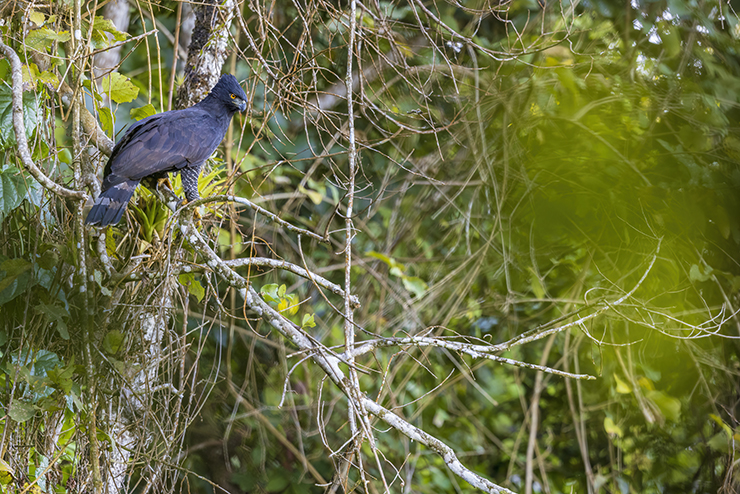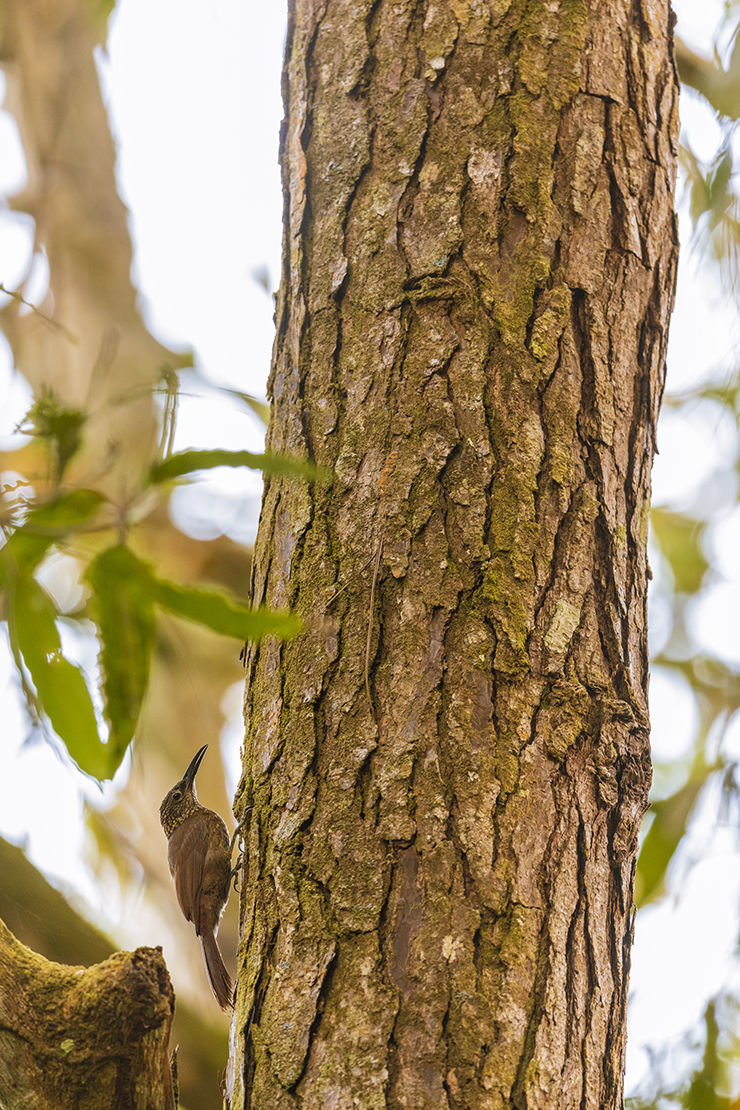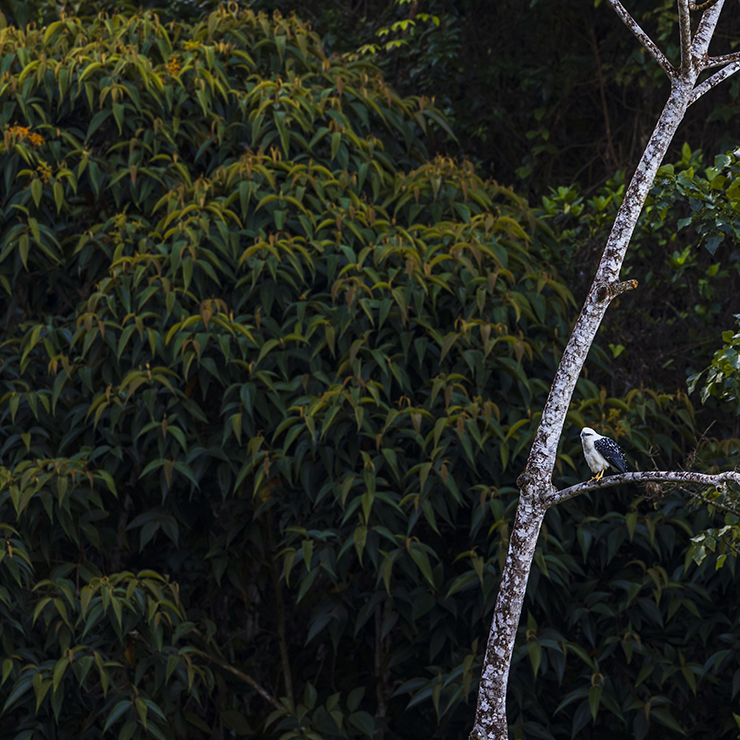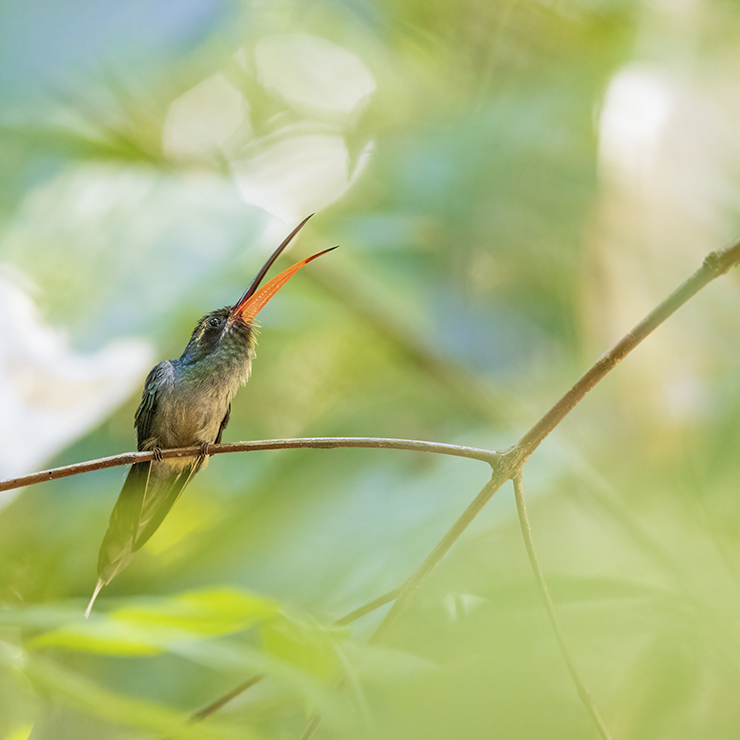
The sky cracked open as we ascended into the modest hills of Trinidad’s Northern Range. Turning into one of the side-roads off the famed Arima-Blanchisseuse Road, we continued our journey uphill. Each corner revealed a staggering amount of damage to the road caused by rushing streams of runoff after excessive rainfall late last year. As we say here, de road wash ‘wey. After some distance along this road, we pulled over and began sauntering along instead.
The thick roadside vegetation concealed many Rufous-breasted Wrens and the odd Stripe-breasted Spinetail. Slowly, the shapes of birds were beginning to materialise. We just needed to find somewhere that was less cluttered to allow us some chance of seeing birds! And so, we continued.
The strident whistle of a Cocoa Woodcreeper was the prelude to its presence, low on a nearby tree. Cocoa Woodcreepers are the largest species of woodcreeper in T&T, and they have a proportionately massive bill. We observed as this bird methodically peeled off sizeable chunks of bark in search of breakfast. I never understood why some woodcreepers would check only a small area of one tree before flying off to another tree. Can they ascertain how profitable a specific tree would be by some sampling method? Or do they just have little patience with unfruitful bark-flipping? Either way, this Cocoa Woodcreeper gave us good looks on a couple of trees before disappearing into the forest.

Cocoa Woodcreeper
We eventually came upon a stretch of clearer vegetation where there was a Rufous-breasted Wren calling close by. While waiting for a visual of this bird, a flock of four or five Red-crowned Ant-Tanagers flew in. Even though they surrounded us and were quite vocal, they were difficult to pin down. The females are virtually the same shade of brown as fallen branches and I’d only see a flash of grey as they took off. I did get a look through binoculars at a fabulous male that hopped up into a shaft of morning light, the pinkish-red feathers of his chin seemed to glow in the darkness of the surrounding foliage. Alas, he was gone before I had a chance to lift my camera.
We continued walking, the sounds of a Channel-billed Toucan calling from the canopy and a more distant but no less distinctive vocalization of a Bright-rumped Atilla beckoned. Some farming activity in the area meant that there had been some manner of clearing created. As if to stamp its approval on the habitat alteration, a Pale-breasted Spinetail voiced its content with the human disturbance. These birds are typically found in scrub and open habitat, how this individual was able to locate this field within the Northern Range is testament to the scale of human disturbance along the roadway.
A white splotch in the distance turned out exactly as I had hoped: White Hawk. These magnificent raptors are also known predators of open habitat. I was especially touched to see this bird, I learned only a few days ago that someone shot one of these birds from another valley I had been familiar with. I photographed it several times, one of these photographs is the title image when wrote about how I had fallen in love with the valley itself. Many friends and guests enjoyed seeing this particular bird soar, hunt, or even sit for hours in the valley.

White Hawk
Not much else was going on. We were unsuccessful in locating a fruiting or flowering plant or tree in good enough view to warrant an extended stay. Some of the immortelle trees were in flower, decorated with extensive epiphytes and the pendulous nests of the Crested Oropendola. The orange flowers were attended to by a host of pollinators including White-necked Jacobin, Black-throated Mango, Purple Honeycreeper, and Green Honeycreeper. However, most of these views were high up, against the bright sky. We opted to return to the vehicle, move on, and bird another trail.
As we were on our way back, we noticed about six Violaceous Euphonias and a couple Golden-fronted Greenlets making a ruckus in a thick bramble. A massive shadow caught our eye on the opposite end, by the time we whispered “Black Hawk-Eagle” to each other it already was in view almost overhead. Miraculously, it dipped down and alighted on one of the woody vines only about thirty metres away! It glared at something in the leaf litter (is there any other way raptors look at anything?) and flew off into the valley, where it caught an updraft and drifted into the white sky.

Black Hawk-Eagle
Perceiving the world by sound reveals much that would otherwise slip through the cracks. On our exit sharp ears picked up the sounds of Green Hermits at a lek. Getting a visual of Trinidad’s largest hummingbird wasn’t going to be easy in the darkness of the undergrowth, though. But certainly not impossible.

Green Hermit in the darkness. For the photographers, the data for this image: 1/80s, f4.5, ISO12800.
Further along, over the crest of the highest peak of the roadway at just about 600m above sea level, we pulled into another side-road. Here, a considerable amount of the forest has been removed for the first hundred or two metres into the road, including several fruit-bearing trees that used to attract a myriad of higher altitude specialists. That depressing news aside, we enjoyed a good view of a female Collared Trogon just out of earshot of the human activity at the entrance. No photograph as yours truly was busy with a bowl of cereal. Shortly after she flew off, there was an episode of deja vu that I wasn’t prepared for.
Another huge spectre bearing the same profile as the previously mentioned shadow glided just beyond the canopy, flared its wings and tail and landed in a nearby tree. Definitely a hawk-eagle, but which? Size and broadness of the wings coupled with a long tail pointed to either of two species but we were not able to discern any colour or pattern from such distance and with that level of obfuscation. We knew it was sitting there, possibly looking at us, but we were unable to locate it. Believe me, we tried!
I still wonder about what could’ve been. I know that there is an Ornate Hawk-Eagle that frequents that area. Was it this bird? Was I really that close to not one, but two hawk-eagles, on one morning? Without any evidence – visual or aural – it’s anyone’s guess.











Leave a Comment